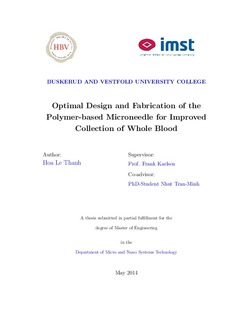| dc.description.abstract | The main purpose of this thesis is to develop a blood-sampling device for extracting whole blood from patient’s fingers. Polymer-based microneedles array has been chosen and developed. Despite that the concept of microneedle has been intensively studied since several decades ago, the fabrication still remains very challenging. Major challenges concerns the high aspect ratio of microneedle structure (length > 1500µm, wall thickness ∼100µm), diminutive and sharp tip. In addition, the microneedles have to be sufficiently strong to avoid fracture and cracks during practical implementation. This thesis covers a total process chain from design, fabrication to performance evaluation of two microneedle designs: traditional-shaped microneedle and pyramid-shaped microneedle.
The first key contribution of this thesis is a highly applicable theoretical model for the optimization of microneedle geometry. The proposed model has been developed to predict the fracture forces. The geometry of microneedle can be optimized to have the highest fracture strength, thus minimizing the failure possibility and increasing safety. A good agreement was observed between the results obtained from analytical solution and from finite element analysis. The improved strength of pyramid-shaped microneedle was also confirmed by practical measurements of fracture force. The results showed that pyramidal tip is stronger than bevel tip with the fracture force of 2.82N compared to 0.51N of bevel tip.
The second contribution of this thesis is a simple, direct and robust method (method 2) proposed for fabrication of SU-8 microneedles. Double exposure is the core technique in method 2, consisting of two exposure steps with high and low exposure dosage, respectively. This fabrication method was initially introduced to improve the remaining challenges of a previously proposed mold-based method - method 1: replication of microneedles. To optimize the process, most of the important fabrication factors were investigated through three main scenarios conducted on three different sloped walls materials: PDMS, SU-8 and aluminum. A CNC-machined aluminum substrate with sloped walls, coated with Cr/Au, showed a big advantage for releasing the microneedles with sharp bevel tips. Microneedles with average tip-size of 23µm were feasible with a single-step of SU-8 lithography. Microneedles can be fabricated with a length up to 1500µm with an aspect ratio of 15.
For practical verification of the fabricated microneedles, skin penetrability was investigated on human fingers. Fabricated microneedles with the proposed designs were sharp and strong enough to puncture the human skin safely. There was blood coming out at several insertion sports, indicating that the microneedle may be long enough to reach the blood vessels. | nb_NO |
